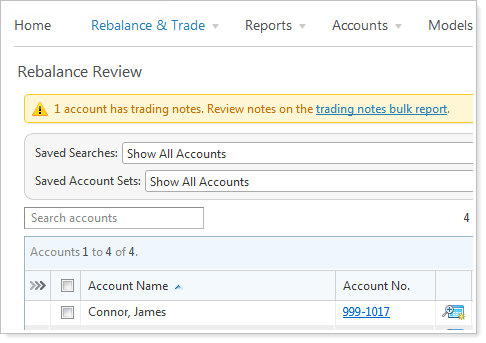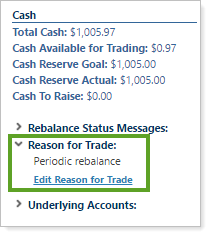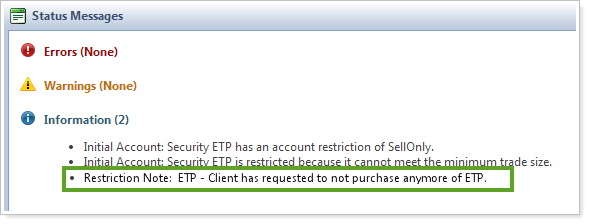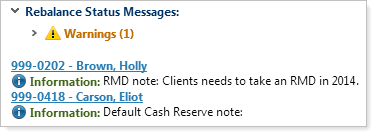Contents
Introduction
Notes in Advisor Rebalancing allow you to add documentation to accounts that can be widely seen by other users who have permission to view those accounts. Client wishes, account changes, alerting to special circumstances, trading notes, and other issues, including compliance issues, can be documented in accounts using notes.
The following icons indicate the type of notes you can find within an account:
| Icon | Meaning |
|---|---|
|
|
This account has account notes |
|
|
This account has no notes |
|
|
This account has trading or order notes |
By clicking one of these icons, you can review notes or add additional notes to that account or rebalancing group. Account notes can be added to individual accounts or rebalancing groups, depending on the type of information you need to document.
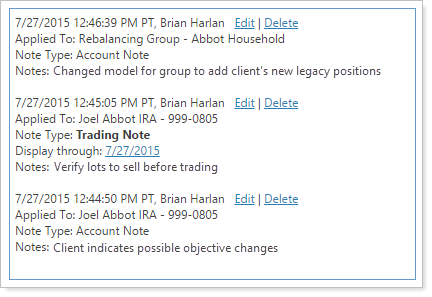
Each account note shows the following information:
-
Date and time the note was added
-
Name of the person who added the note
-
The account or rebalancing group the note applies to
-
Type of note added
-
The text of the note
Why Use Notes?
There is no restriction to the type of information you can add using account notes, so notes can be helpful in documenting situations like these:
-
Reasons for a recent account settings change
-
A client's investing preferences
-
Instructions to traders on how to fill orders for a client
-
Specific reasons for setting a cash reserve
-
Reasons why a security is restricted in a particular client's account
-
Explanation for trading restricted securities or for trading in a non-discretionary account
After adding a note to an account, anyone with permission to view the account will be able to see that note, meaning that important information can be seen widely. Additionally, account notes are reportable, so you can create bulk reports to review account notes, when those notes were added, the person who added the note, and more.
For more information on the process of creating or changing notes, see Add, Edit, and Delete Notes.
Note Types and Viewing Notes
You can view notes in an account in many different places in Advisor Rebalancing. Reviewing notes can be useful before taking action on an account and can give historical context.
Individual Account Notes
You can view historical account notes, as well as other types of notes, in many different locations in Advisor Rebalancing:
| Note Type | Where to View | ||||||||
|---|---|---|---|---|---|---|---|---|---|
|
To view historical notes for an account, including trading notes, visit any of these pages:
Click one of these icons to view a record of notes in that account:
|
||||||||
|
Trading Notes
|
You can view trading notes anywhere you can view account notes. Advisor Rebalancing highlights the notes so that they won't be missed, regardless of who added the note.
Advisor Rebalancing will ask you to enter a trading note when approving a custom strategy that overrides a security restriction. |
||||||||
|
Order Notes
|
You can view order notes anywhere you can view account notes. In addition, Advisor Rebalancing will warn you if order or trading notes exist in an account. Advisor Rebalancing highlights the notes so that they won't be missed, regardless of who added the note.
|
||||||||
|
Reason for Trade Notes
|
You can view any reasons for trade on the Rebalance Summary or Trade Summary pages. You can also access these notes on Bulk Reconciliation bulk report.
|
||||||||
|
Security Restriction Notes
|
You can view any security restriction notes on the Rebalance Summary or Trade Summary pages. These restrictions will then appear along with other information, errors, and warnings you see during the trading and rebalancing process.
|
||||||||
|
Cash Reserve Notes
|
You can view any cash reserve notes in the following places:
|
||||||||
|
Reason for Approval Notes
|
These notes are added before trading in non-discretionary accounts, provided your system settings require approvals for non-discretionary accounts. See System Settings: Trade Approval Settings.
|
Rebalancing Group Notes
Viewing notes for a rebalancing group is very similar to viewing notes for individual accounts. When you view notes for a rebalancing group, you may also see notes for individual accounts within the rebalancing group, and when viewing individual accounts, you may also see notes for a rebalancing group.
The following is a summary of common scenarios when viewing notes:
| Account Type | Results When Viewing Notes |
|---|---|
| Rebalancing Group | You'll see notes added at the rebalancing group level, as well as any account-specific notes for the accounts in that rebalancing group |
| Account within a Rebalancing Group | You'll see notes added at the rebalancing group level, as well as any account-specific notes for the account in which you're viewing notes |
| Account that was removed from a Rebalancing Group | You'll see notes added at the rebalancing group level up until the account was removed from the rebalancing group. You'll also see all notes added to that individual account. |
| Account that was added to a Rebalancing Group | You'll see notes added at the rebalancing group level, even notes that were added before you added the additional account. You'll also see all notes added to the additional account. |
View Notes in Reports
The easiest way to view and audit notes across several accounts is to create a bulk report. Depending on your needs, several bulk reports will provide you with notes information.
The Account Notes bulk report allows you to view notes and associated details in multiple accounts at once. The Restriction Overrides bulk report allows you to see any notes added when a trade overriding a restriction in the Restriction Note field. For more information, see Learn More About Bulk Reports.
When an account contains trading notes or order notes, Advisor Rebalancing highlights this so that these notes aren't missed. In addition, the warning contains a trading notes report link. Click this link to download a report of the trading or order notes on that page.

You can also view order notes on the following reconciliation reports:
-
Bulk Reconciliation
-
Deleted Orders
-
Exception Report
-
Open Orders
-
Trade Tickets
For more information on these reports, visit Reconciliation Reports.
Notes in Non-Discretionary Accounts
Many users have non-discretionary accounts that require you to obtain authorization before you make any investment decisions. If you have the Approval required for non-discretionary accounts option enabled in System Settings, you can prevent trades in non-discretionary accounts from being sent to the Trade List without authorization.
When enabled, Advisor Rebalancing provides a warning when you send trades to the Trade List and requires authorization and an account note before the trades can be approved.
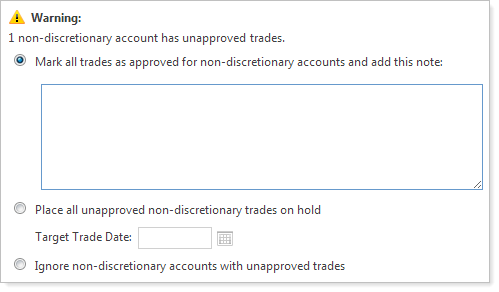
You can then provide a note to explain the reason for the trade in this account.



